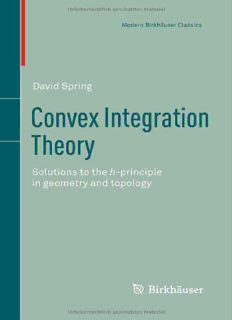Table Of ContentModern Birkha¨user Classics
Many of the original research and survey monographs in pure and
applied mathematics published by Birkha¨user in recent decades have
beengroundbreakingandhavecometoberegardedasfoundationalto
thesubject.ThroughtheMBCSeries,aselectnumberofthesemodern
classics,entirelyuncorrected,arebeingre-releasedinpaperback(and
as eBooks) to ensure that these treasures remain accessible to new
generations ofstudents,scholars,andresearchers.
David Spring
Convex Integration Theory
Solutions to the h-principle in geometry
and topology
Reprint of the 1998 Edition
David Spring
Department of Mathematics
Glendon College
2275 Bayview Avenue
Toronto, Ontario M4N 3M6
Canada
dspring@glendon.yorku.ca
2010MathematicsSubjectClassification58C35, 57R99
ISBN978-3-0348-0059-4 e-ISBN978-3-0348-0060-0
DOI10.1007/978-3-0348-0060-0
(cid:2)c 1998BirkhäuserVerlag
Originallypublishedunderthesametitleasvolume92intheMonographsinMathematicsseriesby
Birkha¨userVerlag,Switzerland,ISBN978-3-7643-5805-1
Reprinted2010bySpringerBasel AG
Thisworkissubjecttocopyright.Allrightsarereserved,whetherthewholeorpartofthematerialiscon-
cerned,specificallytherightsoftranslation,reprinting,re-useofillustrations,broadcasting, reproduction
onmicrofilmsorinotherways,andstorageindatabanks.Foranykindofuse whatsoever, permission
from thecopyrightownermustbeobtained.
Coverdesign:deblik,Berlin
Printedonacid-freepaper
SpringerBaselAGispartofSpringerScience+BusinessMedia
www.birkhauser-science.com
ACKNOWLEDGEMENTS
I should like to thank the many col-
leagues for their personal support ex-
pressed over the years for this book
project. In particular, I thank M. Gro-
mov and Y. Eliashberg for their sound
advice and for their encouragement and
support for my work. I should like to
thank Kam Siu-Man for his assistance
with the illustrations. I also gratefully
acknowledge the financial support that I
have received from NSERC over several
years in support of my research project
for this book.
CONTENTS
1 Introduction .......................................................... 1
§1 Historical Remarks ................................................ 1
§2 Background Material .............................................. 4
§3 h-Principles ....................................................... 10
§4 The Approximation Problem ...................................... 16
2 Convex Hulls ......................................................... 19
§1 Contractible Spaces of Surrounding Loops ......................... 19
§2 C-Structures for Relations in Affine Bundles ....................... 22
§3 The Integral Representation Theorem .............................. 28
3 Analytic Theory ...................................................... 33
§1 The One-Dimensional Theorem .................................... 33
§2 The C⊥-Approximation Theorem .................................. 45
4 Open Ample Relations in 1-Jet Spaces ................................ 49
§1 C0-Dense h-Principle .............................................. 50
§2 Examples ......................................................... 62
5 Microfibrations ....................................................... 71
§1 Introduction ...................................................... 71
§2 C-Structures for Relations over Affine Bundles ..................... 78
§3 The C⊥-Approximation Theorem .................................. 83
6 The Geometry of Jet spaces .......................................... 87
§1 The Manifold X⊥ ................................................. 87
§2 Principal Decompositions in Jet Spaces ............................ 91
viii CONTENTS
7 Convex Hull Extensions .............................................. 101
§1 The Microfibration Property ....................................... 101
§2 The h-Stability Theorem .......................................... 104
8 Ample Relations ...................................................... 121
§1 Short Sections ..................................................... 121
§2 h-Principle for Ample Relations ................................... 132
§3 Examples ......................................................... 145
§4 Relative h-Principles .............................................. 152
9 Systems of Partial Differential Equations .............................. 165
§1 Underdetermined Systems ......................................... 165
§2 Triangular Systems ................................................ 178
§3 C1-Isometric Immersions .......................................... 194
10 Relaxation Theorem ................................................. 201
§1 Filippov’s Relaxation Theorem .................................... 201
§2 Cr-Relaxation Theorem ........................................... 204
References ............................................................. 207
Index .................................................................. 211
Index of Notation ...................................................... 213
CHAPTER 1
INTRODUCTION
§1. Historical Remarks
Convex Integration theory, first introduced by M.Gromov [17], is one of three
general methods in immersion-theoretic topology for solving a broad range of
problems in geometry and topology. The other methods are: (i) Removal of
Singularities, introduced by M.Gromov and Y.Eliashberg [8]; (ii) the covering
homotopy method which, following M.Gromov’s thesis [16], is also referred to
as the method of sheaves. The covering homotopy method is due originally to
S.Smale[36]whoprovedacrucialcoveringhomotopyresultinordertosolvethe
classification problem for immersions of spheres in Euclidean space.
These general methods are not linearly related in the sense that succes-
sive methodssubsumedthepreviousmethods.Each methodhasitsown distinct
foundation, based on an independent geometrical or analytical insight. Conse-
quently, each method has a range of applications to problems in topology that
are best suited to its particular insight. For example, a distinguishing feature of
ConvexIntegrationtheoryisthatitappliestosolveclosedrelationsinjetspaces,
including certain general classes of underdetermined non-linear systems of par-
tial differential equations. As a case of interest, the Nash-Kuiper C1-isometric
immersion theorem can be reformulated and proved using Convex Integration
theory (cf.Gromov [18]). No such results on closed relations in jet spaces can be
proved by means of the other two methods. On the other hand, many classical
results in immersion-theoretic topology, such as the classification of immersions,
are provable by all three methods.
In this context it would of interest to have an historical account of im-
mersion-theoretic topology as it has developed during the past several decades.
The history of immersion theory is rich and complex, with contributions from
many leading topologists in different countries. To date, the literature contains
no general overview of the history of immersion theory. For a brief account of
Convex Integration theory and its relation to the early history of immersion
theory, cf. Spring [39].
Gromov’s treatise [18] serves as a milestone in immersion-theoretic topol-
ogy. In this book, Gromov reformulates and reflects on the basic methods and
D. Spring, Convex Integration Theory: Solutions to the h-principle in geometry and topology, M odern 1
Birkhäuser classics, DOI 10.1007/978-3-0348-0060-0_1, © Springer Basel AG 2010
Description:This book provides a comprehensive study of convex integration theory in immersion-theoretic topology. Convex integration theory, developed originally by M. Gromov, provides general topological methods for solving the h-principle for a wide variety of problems in differential geometry and topology,

